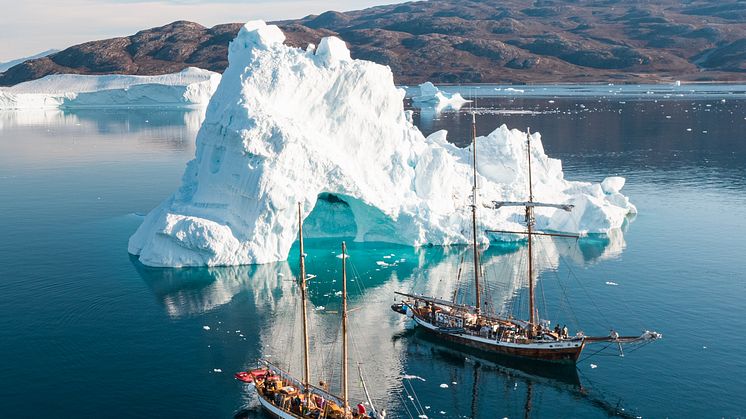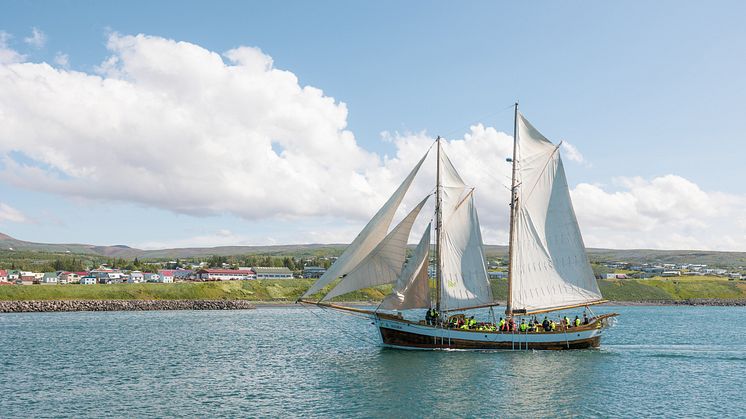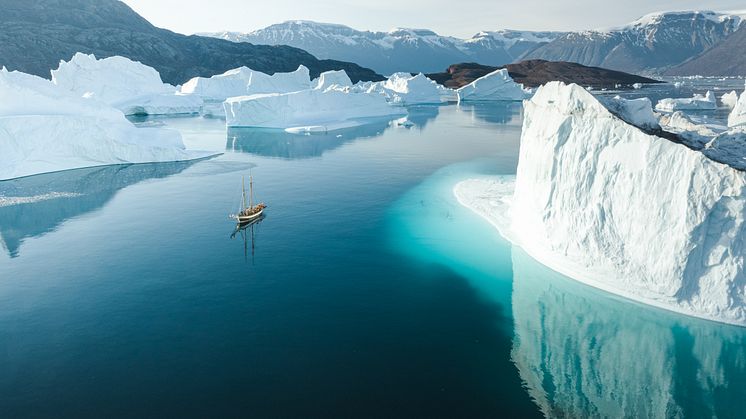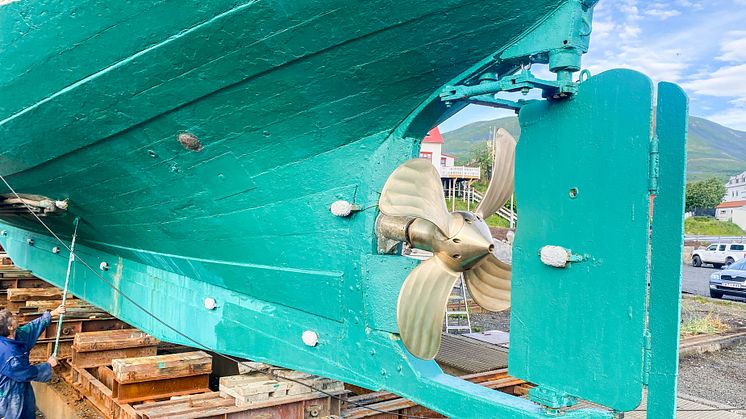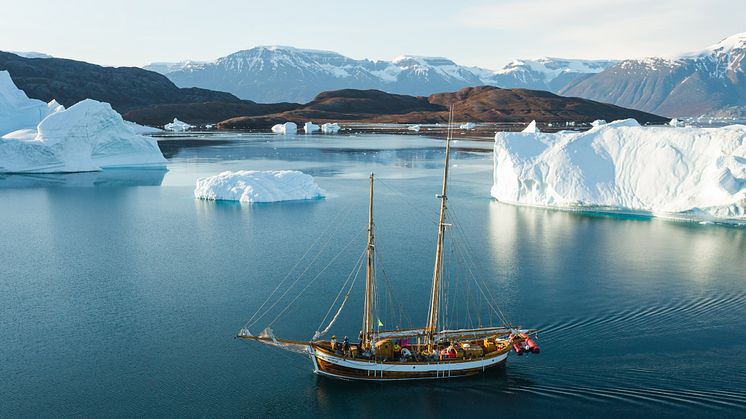
Press release -
Danish propeller systems save fuel and CO2 on historic sailing ships in Iceland
Icelandic North Sailing, in collaboration with the University of Iceland, has shown impressive results in improving fuel consumption and CO2 emissions by retrofitting modern propeller systems on historic sailing ships.
When overfishing, fishing quotas, and the transition to large-scale industrial fishing sent the characteristic Icelandic broad-hulled oak fishing cutter into oblivion in exchange for modern fishing vessels. An important part of Icelandic history and folk spirit was disappearing forever.
For the Sigurbjarnarsons, a family from Húsavík, this development was hard to watch, since fishing from oak boats had been the environment and culture surrounding the family and supporting them the better part of their life. At the time when the head of the family, Sigurbjörn Sörensson, former boat owner and skipper, retired, this tradition appeared to come to an end.
But the sons Hörður Sigurbjarnarson and Árni Sigurbjarnarson went their own way, and with the acquisition and renovation of the oak cutter Knörrinn in 1994, they founded the wildlife tour company North Sailing. Today the company remains in the family's care with Hörðurs son, Heimir Harðarson, active in the board of directors.
– My father and uncle could not let the oak boats disappear forever. They are an essential part of our family's and Icelandic identity and history, so we had to save at least one from demolition. If nothing else, just for the family's sake, says Heimir Harðarson.
Since 1995, North Sailing has offered whale watching trips in the scenic waters around Iceland. The fleet currently includes 11 unique historic wooden boats from Iceland, Denmark, and Germany.
– Through North Sailing, we can preserve these wonderful vessels, so future generations can experience history and nature through guided tours, says Heimir Harðarson.
New Propellers on Old Boats
Parallel with their desire to preserve the historic boats, it was important for the brothers from the start that their business should minimize their environmental footprint. Since the boats are typically between fifty and one hundred years old, that goal can be a challenge, due to the vessels' old and polluting engines. As a result, improved fuel utilization and propulsion have always been highly prioritized when time came for the boats to be renovated and prepared for use again.
– By renovating the boats in North Sailing, we have a unique opportunity to test different engine and fuel solutions that hopefully contribute to greener shipping. That is why we’re always curious about solutions that can improve our and other boats' environmental footprint, says Heimir Harðarson.
Most recently, Heimir and his team have turned their attention to the vessels' propeller systems to find the most optimal propulsion solution. When the team retrofitted the schooner Hildur's old propeller with a new one from Danish Hundested Propeller, improvements were to be expected. Still, the result came as a surprise.
University of Iceland is on the Case
Before installing the propeller, Heimir contacted professor Rúnar Unnþórsson and Satish Kumar Bonthu from The Faculty of Industrial Engineering, Mechanical Engineering and Computer Science at the University of Iceland. They made plans for measuring and evaluating the improvement in performance and fuel consumption compared to the original propeller.
The study showed a consistent 30 percent reduction in fuel consumption and improved speed. The reduction of CO2- emissions was also reduced by 30 percent.
– The result was above and beyond our expectations. Rúnar and Satish's study clearly shows that retrofitting propellers is not only a good financial investment for the boat owner but is also a win for the climate. We hope we can spread this message through our work at North Sailing, says Heimir Harðarson.
The study’s conclusion resonates with the researchers behind it.
– Systematic measurements were made at different speeds, logging fuel consumption, sailing speed, wind speed and other weather data. The results of this study clearly show that the shipping and fishing industry can drastically reduce their fuel cost and carbon footprint with existing technology. In short, there is no excuse to hesitate any longer, says professor Rúnar Unnþórsson, who is head of the study.
Facts:
North Sailing, Schooner Hildur
Hildur was built in Akureyri in 1974 by two shipwrights, Gunnlaugur and Trausti. Trausti and sons would later become good friends with North Sailing and help the company convert most of its boats into passenger vessels. North Sailing owners got to know their special skills and enthusiasm for wooden boats and set a goal to later behold one of the three big wooden boats built in their shipbuilding station. It was then in the summer of 2009 that Hildur sailed into Husavik Harbour but only for a rather short visit in the local shipyard for overhaul before a 10-day journey to Denmark where she would be converted into a two masted schooner with 280 sqm of sails in the shipyard of Christian Jonsson in Egernsund.
- Gross tonnage: 35
- LOA: 26 m (LOD 18m)
- Beam: 4,8 m
- Sail area: 280 sqm
- Hull material: Scandinavian White Oak
- Built, where: Akureyri
- Built/rebuilt: 1974/2010
- Passenger capacity: 50
- Engine: Scania
- kW/horsepower: 130/177
- Propeller System: Hundested VP7 FR-HP Controllable Pitch Propeller with Hydraulic Pitch Control Unit
- Port of registry: Húsavík
- Flag: Iceland
Hundested VP7 FR-HP Controllable Pitch Propeller with Hydraulic Pitch Control Unit
General:
- Type: VP7 FR-HP
- Propeller power: 144kW
- Propeller speed: 244 RPM
Propeller:
- Number of blades: 4 pcs
- Propeller diameter: 1400 mm
- Direction of propeller rotation: CW
- Blade material: Ni-Al-Bz
- Hub material: Ni-Al-Bz
- Lubrication: Recommended grease
- Amount of grease in hub: 8 kg
- Total weight of hub+blades: Approx. 255 kg
Propeller shaft:
- Material propeller shaft: 1.4404
- Outside diameter at bearings: 120 mm
- Inside diameter: 40 mm
- Weight: Approx.205 kg
FR-HP pitch control unit:
- Lubrication: ISO 68 hydraulic oil
- Oil quantity: Approx. 10 L
- Maximum oil temperature: 45 °C
- Weight: 140 kg
Hundested Propeller develops and produces propulsion systems and custom solutions for maritime vessels all over the world and are among the leading producers in the field. Read more about the company at www.hundestedpropeller.com


